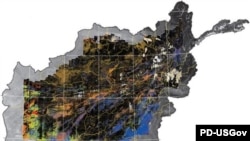Afghanistan has become the first country in the world to have its surface minerals mapped from the air.
The U.S. Geographical Survey (USGS) mapped some 70 percent of the country using an advanced technique known as “hyperspectral imaging,” which involves using a camera to capture sunlight reflected from the ground.
Specific colors on the mineral map reflect different natural minerals as well as man-made minerals, vegetation, and snow.
USGS spokesman Alex Demas maintains that the map will make it easier to identify and estimate mineral deposits for international mining companies looking to invest in Afghanistan, which is known to have vast reserves of oil, gas, copper, cobalt, gold, and lithium.
“This imagery allows us to identify with very good accuracy where certain types of materials are," he says. "And this is very useful, especially for the mining industry. In fact, the USGS and the Afghan Geological Survey have already identified, using this information, 24 areas of high-profile mining interests.”
Demas adds the survey did not include regions inside Afghanistan that bordered its neighbors—Iran, Pakistan, China, Tajikistan, Turkmenistan, and Uzbekistan-- in order to avoid any concerns over airspace.
International mining companies have made huge investments in Afghan mining in recent years.
In 2008, the China Metallurgical Group Corporation made a successful bid of $3 billion for mineral rights to the Mes Aynak site, which geologists believe has the second-largest copper reserves in the world.
That was followed by a bid from a group of Indian companies in 2011, when a deal was signed to begin mining Hajigak, the country’s largest iron ore deposit, located in the central Bamiyan Province.
The numbers being used to describe Afghanistan's potential wealth are staggering.
In 2010, the Afghan Ministry of Mines estimated that the country’s reserves could amount to some one trillion dollars.
According to Demas, from the data the USGS has received, the minerals that have been discovered by the mineral map seem to be the real deal.
“We do believe these to be world-class mineral deposits," he says. "We don’t know for certain what the tonnage of mineral ore will be. We won’t know for sure, though, until a company actually goers there and develops it.”
The USGS gathered the data over the space of 43 days from aircrafts travelling at a height of 15,000 meters.
The project was funded by the U.S. Department of Defense’s Task Force for Business and Stability Operations as well as by the Afghan government.
-- Frud Bezhan
The U.S. Geographical Survey (USGS) mapped some 70 percent of the country using an advanced technique known as “hyperspectral imaging,” which involves using a camera to capture sunlight reflected from the ground.
Specific colors on the mineral map reflect different natural minerals as well as man-made minerals, vegetation, and snow.
USGS spokesman Alex Demas maintains that the map will make it easier to identify and estimate mineral deposits for international mining companies looking to invest in Afghanistan, which is known to have vast reserves of oil, gas, copper, cobalt, gold, and lithium.
“This imagery allows us to identify with very good accuracy where certain types of materials are," he says. "And this is very useful, especially for the mining industry. In fact, the USGS and the Afghan Geological Survey have already identified, using this information, 24 areas of high-profile mining interests.”
Demas adds the survey did not include regions inside Afghanistan that bordered its neighbors—Iran, Pakistan, China, Tajikistan, Turkmenistan, and Uzbekistan-- in order to avoid any concerns over airspace.
International mining companies have made huge investments in Afghan mining in recent years.
In 2008, the China Metallurgical Group Corporation made a successful bid of $3 billion for mineral rights to the Mes Aynak site, which geologists believe has the second-largest copper reserves in the world.
That was followed by a bid from a group of Indian companies in 2011, when a deal was signed to begin mining Hajigak, the country’s largest iron ore deposit, located in the central Bamiyan Province.
The numbers being used to describe Afghanistan's potential wealth are staggering.
In 2010, the Afghan Ministry of Mines estimated that the country’s reserves could amount to some one trillion dollars.
According to Demas, from the data the USGS has received, the minerals that have been discovered by the mineral map seem to be the real deal.
“We do believe these to be world-class mineral deposits," he says. "We don’t know for certain what the tonnage of mineral ore will be. We won’t know for sure, though, until a company actually goers there and develops it.”
The USGS gathered the data over the space of 43 days from aircrafts travelling at a height of 15,000 meters.
The project was funded by the U.S. Department of Defense’s Task Force for Business and Stability Operations as well as by the Afghan government.
-- Frud Bezhan








